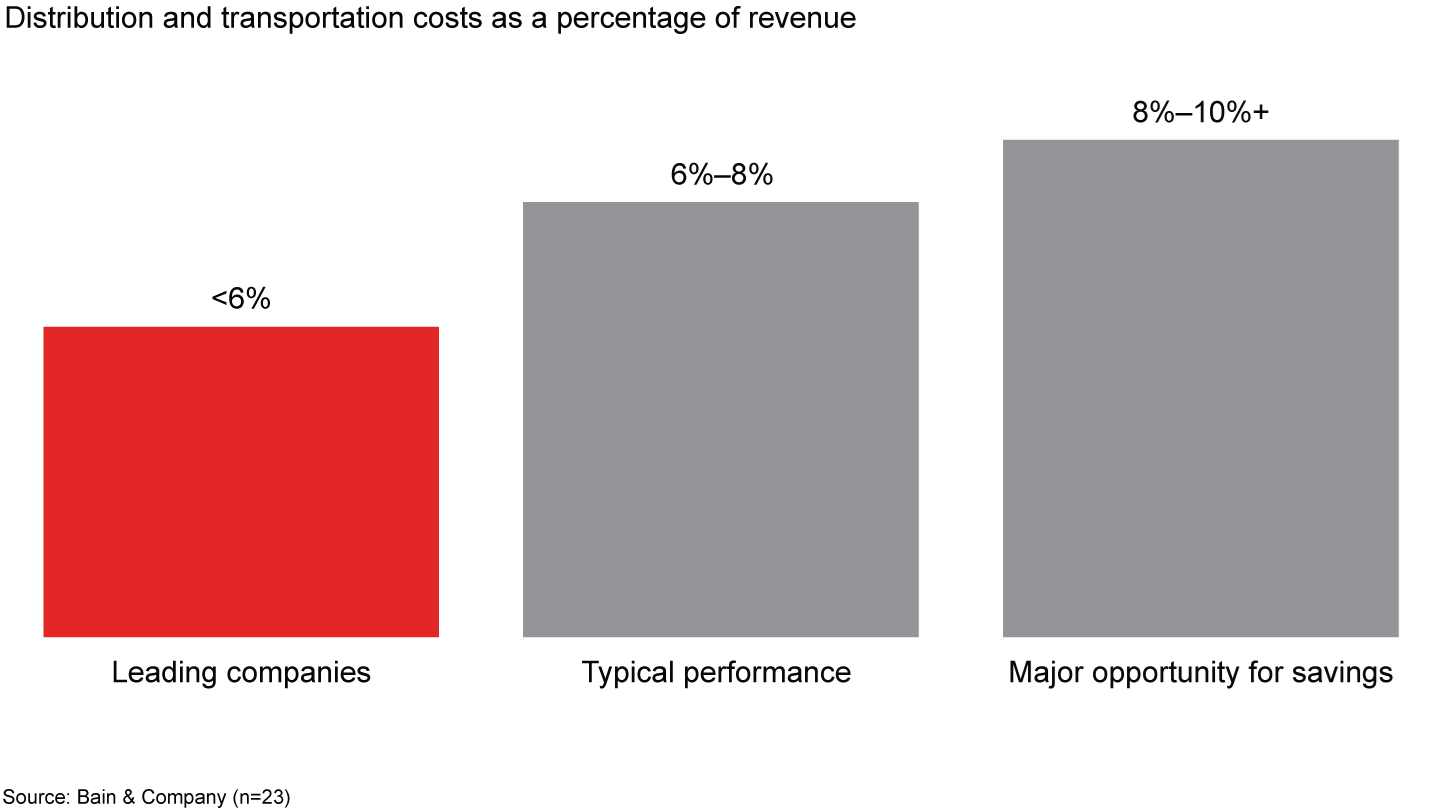Brief

Executive Summary
- Distribution and transportation costs can spiral out of control as companies build or acquire overlapping manufacturing sites and warehouses around the world.
- Companies with inefficient networks can lower their distribution and transportation costs by as much as 25%.
- A small, well-designed distribution network can provide better service at lower cost than a larger one that is poorly designed.
It was a moment of truth for the leadership team at one global consumer goods manufacturer. After years of rapid expansion that included several acquisitions, the company’s distribution network had become overly complex, inefficient and costly. Its 150 distribution centers and 150 warehouses spanned the world—but they operated independently.
The cost of that inefficiency was staggering. Lacking the technology to coordinate shipments, distribution center staff sent multiple trucks every day to the same customer to deliver different orders, instead of consolidating them. A pilot program in one division to improve distribution and transportation efficiency recommended closing inefficient distribution centers and investing in the optimally located facilities to improve process flow and technology. It concluded that those moves, applied company-wide, would yield more than $100 million in savings.
For many leadership teams, ballooning distribution and transportation costs are a silent peril. As companies grow, they tend to build or acquire a hodgepodge of overlapping manufacturing sites, distribution centers and warehouses throughout the world. Often, many of these potential shipping locations are poorly designed and in the wrong place to address customers’ needs, with too much capacity in one region and not enough in another. The result is spiraling distribution and transportation costs.

Building an Efficient Distribution and Transportation Network
Reining in soaring costs presents a major opportunity for consumer product companies.
Worse, those mounting costs often go unnoticed. When companies benchmark their productivity, they tend to focus on manufacturing processes, not the full supply chain. As a result, they overlook inefficient distribution networks—and a huge cost-reduction opportunity. Typically, distribution and transportation costs for consumer packaged goods companies range from 6% to 8% of revenues (see Figure 1). In our experience, companies with inefficient networks can lower their distribution network costs by 10% to 25% by upgrading their systems (see Figure 2). Just as important, they improve service, reduce inventory and avert tens of millions of dollars in unnecessary investment.
Leading consumer packaged goods companies have significantly lower distribution and transportation costs than competitors


A world-class distribution network lowers costs and improves service


Some leadership teams are reluctant to take on the time-consuming and complex challenge of redesigning distribution networks. But successful companies increasingly see best-in-class distribution as a strategic advantage. They develop a distribution strategy and invest in systems and technologies that deliver productivity gains year after year. Companies that neglect to upgrade their distribution and transportation systems because the effort is too costly or complex risk finding themselves at a huge cost and service disadvantage—much like competitors of Amazon that failed to invest in online capabilities.
Design a world-class supply chain
Companies aiming to build highly efficient supply chains start with a clear view of their distribution and transportation costs. They identify decisions that could increase costs or reduce on-time deliveries, then simulate different logistics options. That vital information allows them to design a top-performing distribution network.
The biggest challenge in reshaping a distribution strategy is determining the right cost structure for each business unit and key customers, while also meeting rising service expectations. Individual business units may have different priorities and conflicting views about what is best for the company. Digital tools and modeling can help leadership teams avoid unsatisfactory choices and determine a distribution center footprint that delivers the best overall performance.
When the consumer products company with 150 distribution centers and 150 warehouses set about redesigning its network, business unit leaders disagreed about which model would achieve the best result. The leadership team quickly realized that each business unit wanted what was best for its P&L, and none had the bird’s eye view to understand what was best for the company as a whole.
To get a broader perspective on the optimal distribution footprint, it deployed advanced digital simulation tools. The modeling exercise dispelled managers’ misperceptions and helped the entire organization understand important opportunities to improve total distribution network efficiency, even if costs increased for one or two divisions. Above all, it allowed the leadership team to equitably share those cost savings among all business units and create support for a more efficient company network.
Rob Ruffin, an expert vice president with Bain's Performance Improvement practice, describes the three guidelines for building smaller, more strategic and well-designed distribution and transportation networks that can reduce costs.
A small, well-designed distribution network can operate more efficiently than a large one. One food and beverage maker realized its 14 far-flung distributions centers were generating costs far above those of the competition. The leadership team streamlined its network, reducing the number of distribution facilities to 9 from 14 and total square footage by 50%, while ensuring its remaining centers were in the best locations. At the same time, it invested in digital tools and advanced automation to improve efficiency. Downsizing and reshaping its distribution network reduced costs by more than 20%, while improving its service levels. Same-day shipment for e-commerce rose to more than 95%, while service levels reached the on-time target of 98%.
Leading companies define a long-term strategy and use quick wins to help sustain a multiyear transformation. Take the case of a home accessories company that produced a jolt of savings within 12 months by deploying lean tools, redesigning the internal layout of its distribution centers and investing in digital technologies to automate processes. The leadership team used the savings to help finance ongoing investment in a world-class network. To date, that plan has cut total distribution and transportation costs by 15%, while improving service levels. The company’s three-year target is a 40% reduction.
Some companies become overly focused on short-term gains, but actions that are not part of a long-term plan risk undercutting efficiency. Managers may negotiate lower warehouse rental rates by locking in a long-term contract, for example, only to realize soon afterward that the warehouse is in a location that is not strategic and should be closed. Given the high cost of breaking the lease, the contract handcuffs the company and slows its progress toward building a more efficient network.
Another common mistake leadership teams make is assuming that digital tools by themselves can create an efficient distribution network. Successful companies understand that networks that are poorly designed to meet customers’ needs can undercut performance. As a result they avoid digitalizing poor processes or employing the wrong decision-making algorithms in the search for better outcomes. Instead, they use digital tools to help support a customer-focused distribution strategy.
Staying on top
Many variables can affect network efficiency, including a changing customer profile, rising costs and changing customer demands. Successful companies monitor their distribution and transportation performance and adjust their networks as needed.
The trick is balancing cost, investment and service levels. Leaders track performance metrics and targets such as on-time and in-full delivery, or total distribution and transportation cost (as a percentage of sales) as real-time indicators. Digital tools and advanced analytics can help companies create and sustain competitive advantage.
Warehouse management systems, for example, identify demand patterns and recommend where to place inventory to reduce worker transit time. Drones equipped with radio frequency identification (RFID) technology give warehouse managers a description of total inventory within minutes, with greater than 99% accuracy.
Building the capability to deploy digital tools is a challenge for many companies. Those with best-in-class distribution and transportation networks take a dual approach. They provide digital training for their own distribution and transportation team and augment the company’s base of skills by hiring industry experts. That approach builds the talent and skills to quickly identify opportunities to improve network efficiency.
Companies face growing pressure to continually boost productivity, but it is not always easy to squeeze more efficiency from manufacturing processes. For many, redesigning distribution and transportation networks can deliver significant savings, as well as a competitive edge—as long as investments are tied to a smart, long-term strategy.
A multinational with $10 billion in annual sales, for example, will spend an average of $3.5 billion on distribution and transportation over five years. Despite the large financial outlay, companies often are disappointed with the level of service they can offer and their inability to meet customer expectations. Leadership teams have two choices: They can let their networks grow organically, with the risk that they reel out of control. Or they can step back and tailor their supply chain investments to the company’s business strategy, reaping substantial savings and transforming their distribution networks into competitive weapons.
Rob Ruffin is an expert vice president in Bain & Company’s Performance Improvement practice, and is based in Boston. Meghan Shehorn is a Bain partner in the Chicago office. Debjit Banerjee is an expert principal in Bain’s New York office. Jared Lapin is an expert principal in the firm’s Chicago office.